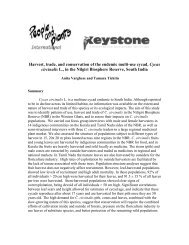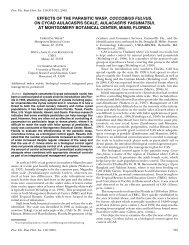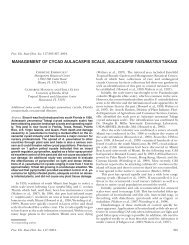Glossary of terms used in cycad systematics - Cycad Specialist Group
Glossary of terms used in cycad systematics - Cycad Specialist Group
Glossary of terms used in cycad systematics - Cycad Specialist Group
You also want an ePaper? Increase the reach of your titles
YUMPU automatically turns print PDFs into web optimized ePapers that Google loves.
Walters & Osborne – <strong>Cycad</strong> Classification: Concepts & Recommendations, Appendix 2 17<br />
phylogeny. Evolutionary history <strong>of</strong> an organism or group.<br />
physiographic. Relat<strong>in</strong>g to physical geography.<br />
physiology. Study <strong>of</strong> the function<strong>in</strong>g <strong>of</strong> organisms and their parts.<br />
phytochemistry. Study <strong>of</strong> plant chemistry, particularly <strong>in</strong> relation to secondary metabolites.<br />
phytogeography. Study <strong>of</strong> plants and their distribution <strong>in</strong> relation to geographic factors.<br />
pilose. With s<strong>of</strong>t hairs. See also lanate, hirsute, pubescent, sericeous, tomentose.<br />
p<strong>in</strong>na, plural p<strong>in</strong>nae. Primary division <strong>of</strong> a compound leaf; leaflet.<br />
p<strong>in</strong>nacanth. Sharply-po<strong>in</strong>ted structure <strong>in</strong>termediate between a leaflet and a sp<strong>in</strong>e, usually green and<br />
hence photosynthetic, as seen <strong>in</strong> on the rachises <strong>of</strong> some species <strong>of</strong> Dioon, Encephalartos and<br />
Macrozamia. See also prickle, tooth.<br />
p<strong>in</strong>nate. Feather-shaped; typically a leaf with leaflets or p<strong>in</strong>nae on either side <strong>of</strong> a rachis. See also<br />
bip<strong>in</strong>nate, multip<strong>in</strong>nate, p<strong>in</strong>nule.<br />
p<strong>in</strong>nule. Secondary division <strong>of</strong> a compound leaf. See also p<strong>in</strong>na.<br />
planche. French term <strong>used</strong> <strong>in</strong> some <strong>of</strong> the older botanical literature to denote illustrative plate. See also<br />
tabula.<br />
platyspermic. Of seeds, flattened so as to be not radially symmetrical, as <strong>in</strong> Cycas seeds. See also<br />
act<strong>in</strong>omorphic, zygomorphic. Cf. radiospermic.<br />
plesiomorphy. Ancestral or underived character or character state. Note that a plesiomorphy at a given<br />
hierarchical level may be an apomorphy at a more <strong>in</strong>clusive level. See also autapomorphy,<br />
homology, symplesiomorphy, synapomorphy.<br />
plicate. Pleated or folded longitud<strong>in</strong>ally to give as corrugated appearance, as for the leaflet surface <strong>of</strong><br />
Zamia roezlii.<br />
plumose. Feathery <strong>in</strong> a whorled appearance.<br />
pollen. F<strong>in</strong>e powdery material (microspores) shed from the microsporangia <strong>of</strong> seed plants; <strong>in</strong> <strong>cycad</strong>s<br />
sometimes referred to as prepollen; microspores conta<strong>in</strong><strong>in</strong>g a male gametophyte<br />
(microgametophyte).<br />
pollen cone/strobilus. Male cone; microsporangiate strobilus.<br />
poll<strong>in</strong>ation. Transfer <strong>of</strong> pollen towards ovules. See also anemophily, entomophily.<br />
polymorphic. Persistently variable <strong>in</strong> form, as for populations <strong>of</strong> Macrozamia polymorpha and Zamia<br />
polymorpha. See also dimorphic, homomorphic, monomorphic.<br />
polyphyletic. Of an artifical group compris<strong>in</strong>g members that have orig<strong>in</strong>ated <strong>in</strong>dependently from more<br />
than one ancestor. See also monophyletic, paraphyletic.<br />
polythetic. Referr<strong>in</strong>g to a group shar<strong>in</strong>g many, but not all, features. See also monothetic.






